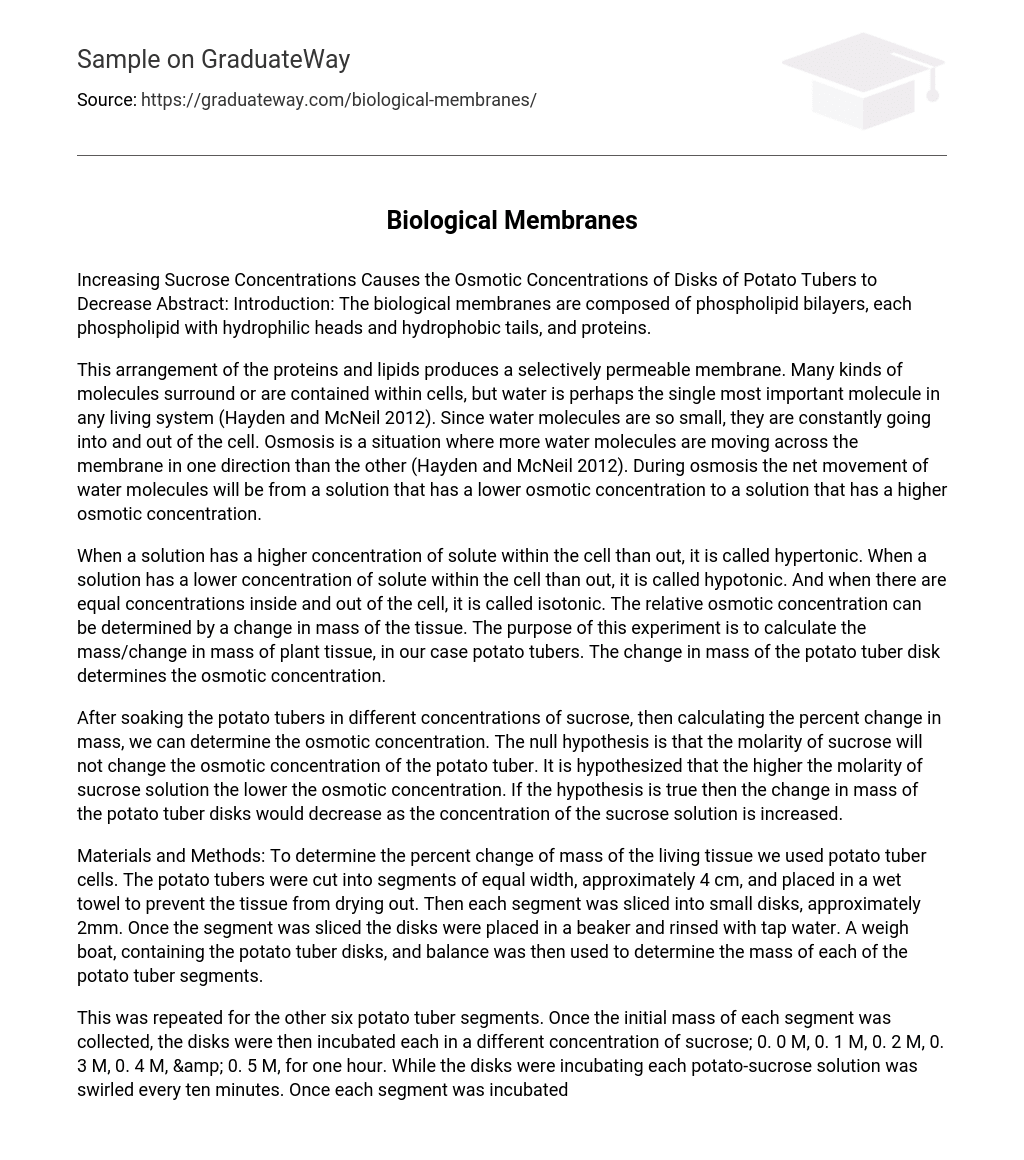Increasing sucrose concentrations causes the osmotic concentrations of disks of potato tubers to decrease.
Abstract:
Introduction: Biological membranes are composed of phospholipid bilayers, with each phospholipid having hydrophilic heads and hydrophobic tails, as well as proteins.
This arrangement of proteins and lipids produces a selectively permeable membrane. Many kinds of molecules surround or are contained within cells, but water is perhaps the single most important molecule in any living system (Hayden and McNeil, 2012). Since water molecules are so small, they constantly move into and out of the cell. Osmosis occurs when more water molecules move across the membrane in one direction than the other (Hayden and McNeil, 2012). During osmosis, the net movement of water molecules will be from a solution with lower osmotic concentration to a solution with higher osmotic concentration.
When the concentration of solute within a cell is higher than outside, it is called hypertonic. When the concentration of solute within a cell is lower than outside, it is called hypotonic. If there are equal concentrations inside and outside the cell, it is referred to as isotonic. The relative osmotic concentration can be determined by measuring the change in mass of tissue. The purpose of this experiment is to calculate the change in mass of plant tissue, specifically potato tubers, to determine osmotic concentration.
After soaking potato tubers in various concentrations of sucrose and calculating the percentage change in mass, we can determine their osmotic concentration. The null hypothesis is that the molarity of sucrose will not affect the osmotic concentration of the potato tuber. It is hypothesized that as the molarity of sucrose solution increases, the osmotic concentration decreases. If this hypothesis is true, then there would be a decrease in mass change for potato tuber disks as we increase the concentration of sucrose solution.
Materials and Methods:
To determine the percentage change in mass of living tissue, we utilized potato tuber cells. The potato tubers were sliced into segments of equal width, approximately 4 cm, and kept in a wet towel to avoid drying out the tissue. Each segment was then cut into small disks about 2mm thick. The disks were rinsed with tap water before being placed in a beaker. A weigh boat containing the potato tuber disks was used with a balance to determine the mass of each segment.
This process was repeated for the other six potato tuber segments. First, the initial mass of each segment was collected. Then, the disks were incubated in different concentrations of sucrose: 0.0 M, 0.1 M, 0.2 M, 0.3 M, 0.4 M, and 0.5 M for one hour.
While the disks were incubating in each potato-sucrose solution, they were swirled every ten minutes to ensure proper mixing.
After one hour of incubation time for each segment, the solution was removed from the disks and they were blotted on a paper towel before being weighed again to obtain their final mass which was recorded.
We used the initial and final mass to determine the change in mass for each segment. The results showed that by measuring the initial and final mass of potato tubers, we could find the change in mass. Dividing this number by the initial mass and multiplying it by 100 helped us determine the percent change in mass. As shown in Figure 1, we found that as sucrose concentration increased, percent change in mass decreased. This also meant that relative osmotic concentration decreased with increasing sucrose concentration.
The osmotic concentration was greater than zero in sucrose solutions of 0.0 M. The osmotic concentrations were less than zero in sucrose solutions of 0.1 M, 0.4 M, and 0.5 M. The osmotic concentrations were zero in sucrose solutions of 0.2 M and 0.3 M.
At a sucrose concentration of 0.1 M, the change was negative which did not fit the trend line; however, if the experiment was repeated a few times, that would probably change.
The percent changes in mass from 0 to 0.5 M were very dramatic (see Figure 1: Percentage change in potato tuber mass vs. sucrose concentration).
The percent change in mass decreased as the sucrose concentration increased. The relative osmotic concentration was measured as the percent change in mass of sucrose concentration over one hour. During the discussion, it was noted that cells need water. If a cell is hypertonic, it means that the solution had more solute than the cell. If a cell is hypotonic, it means that the solution had less solute than the cell. If a cell is isotonic, it means that the solution had an equal amount of solute to the cell’s environment.
Source: Wischusen, William, Jolissaint, Ann, Reiland, Jane and Pomarico Steven (2012). Biology 1208/1209: Biological Laboratories for Science Majors. Hayden McNeil: Plymouth Michigan.





